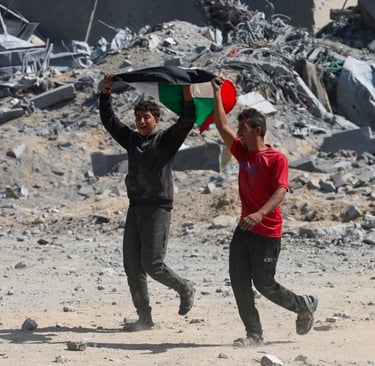Palestine: A Ceasefire’s Small Window for Aid and Stabilization
The brutal conflict in Gaza has entered a fragile new phase, shifting the narrative from endless fighting toward the possibility of political solutions and reconstruction. Will this temporary pause lead to a lasting transition toward peace, or a mere lull before the next destructive round of violence?
ISRAELPALESTINE
Aiym Seidakhmet
10/17/20253 min read


After nearly two years of intense conflict, destruction, and a humanitarian catastrophe in Gaza, we may be witnessing a subtle but important shift between Israel and Hamas. There’s a growing sense that the relentless fighting is no longer the only story. A U.S.-brokered ceasefire has brought a slowdown in large-scale airstrikes and opened a limited door for humanitarian aid into the enclave. At the same time, the United States has submitted a draft resolution to the United Nations Security Council that proposes an international stabilization force for Gaza with a two-year mandate. This plan would involve deploying troops, providing civilian aid, undertaking reconstruction efforts, and potentially disarming certain militaristic groups.
Despite some hopeful signs, the conflict is far from over. Aid groups say that only a small number of the promised trucks carrying food, shelter, and fuel are reaching Gaza, while winter is coming and many neighborhoods are still destroyed. This means the situation is more of a temporary pause in fighting than a real solution, resulting in a small chance for diplomacy but leaving the main problems unsolved.
The change in narrative is significant. Israel, struggling with mounting international criticism over the impact of its offensive in Gaza, appears to be shifting publicly from talk of retaliation toward talk of rebuilding and diplomacy. That shift is partly pragmatic. Israel’s global reputation, especially in Europe and the Arab world, has been badly damaged. However, it also shows that Israel may be more open to pursuing long-term political solutions instead of focusing only on military action. As for Hamas, the group is still active, it still has weapons, wants to show it can survive, and refuses full disarmament. But the fact that it is taking part in talks, even indirectly, and joining in exchanges of bodies and hostages shows that the conflict is starting to change. What’s happening across the Middle East may be even more revealing. Before the conflict grew worse, several Arab countries were slowly moving toward normalizing relations with Israel through agreements like the Abraham Accords. But the destruction in Gaza and the subsequent public anger have made that process much more difficult. Countries like Saudi Arabia, Jordan, and Egypt now face strong pressure at home, as their governments can not ignore the widespread anger over the war. At the same time, Iran is using the unrest to expand its influence by backing groups like Hamas and Hezbollah and positioning itself as an important force in shaping the region’s future.
This conflict highlights how global power is shifting not just in the Middle East, but in other regions of the world as well. The U.S. is still Israel’s closest ally, but its ability to control events in the Middle East has weakened. Washington is stretched thin, with Ukraine, China, the Indo-Pacific, and now Gaza all demanding attention and resources. Into this gap, Russia and China are stepping in as alternative power players, promoting their own views and trying to gain influence among countries that feel ignored or frustrated by Western diplomacy. The recent U.S.-drafted UN resolution on stabilizing Gaza reflects this change. It proposes a temporary governing body and a force allowed to take “all necessary measures” to maintain order. But making it happen would require agreement from several major powers that haven’t always supported U.S. plans. In essence, this war is not yet over. The large-scale fighting may have slowed, but many questions concerning the future of Gaza, the armament of Hamas, and trends in the military security of Israel remain unresolved. The humanitarian situation is still dire, there is no clear political solution ahead, and even a small incident could trigger renewed violence.
However, for the first time in a long while, there is a window of opportunity for something more durable. The ceasefire and the stabilization proposals give space for reconstruction, dialogue, and reform if the regional and global actors seize it. In the coming months, many will wonder about the viability of this latest truce, whether it will impart significant change within the broader region of the Levant, and what reconstruction might look like moving forward. Some might also wonder whether Arab states will ever resume attempts to normalize relations with Israel, or if these efforts will remain halted due to an increase in public outrage. It also remains to be seen which global powers might take a lead in shaping the future of Israel and Palestine. This moment could mark a key turning point for the region. For Gaza, Israel, and the wider Middle East, the narrative might be moving away from the binary of war or peace and toward transition, from destruction to rebuilding, from rejection to diplomacy, from unilateral action to multilateral complexity. Whether that transition leads to a genuine and lasting peace, or merely to a pause before another round, depends heavily on the choices made now.
The war between Israel and Hamas is not over. Many questions remain about the viability of this ceasefire and the impact it might have in the coming weeks and months. However, there have been noticeable changes in regional trends involving Israel and other Middle Eastern powers, leaving the international community to wonder what the future holds. This alteration might define not just the future of Israel and Palestine, but the regional and global landscape as well.


